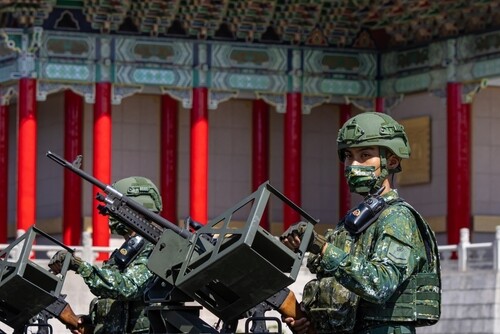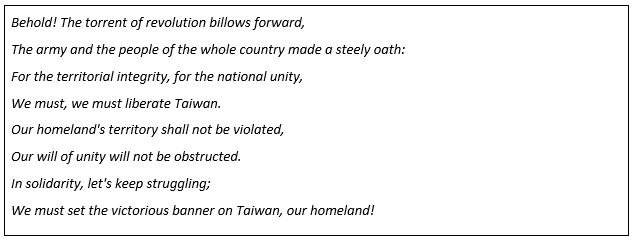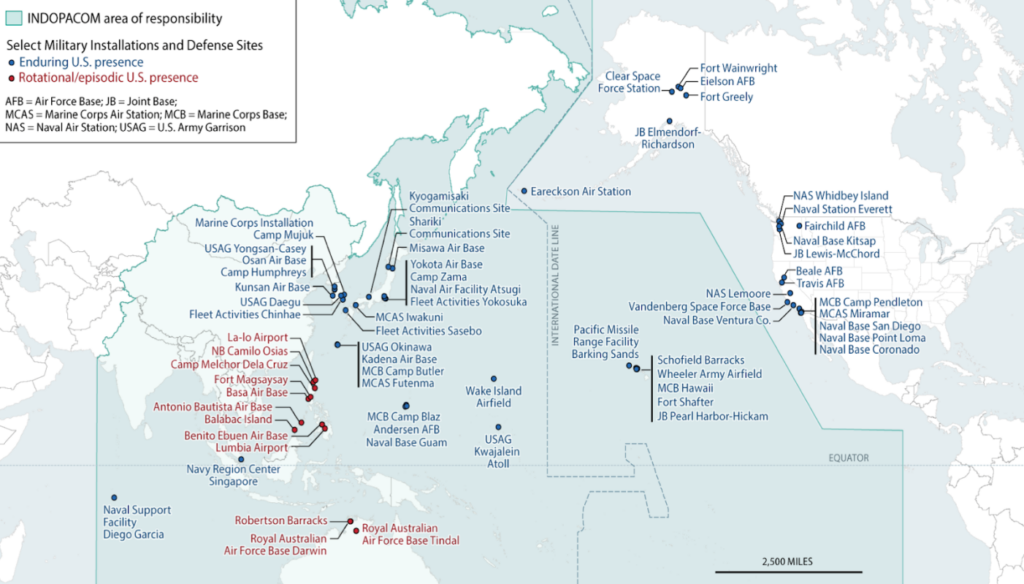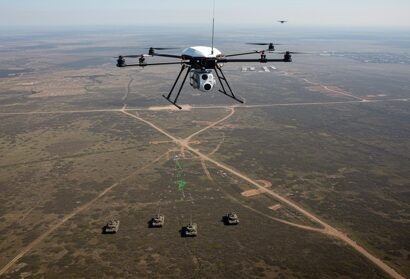Abstract: Amidst a meteoric rise to power in the political-economic domains, China has ramped up aggressive nationalist overtures regarding reunification with Taiwan. While this provides a basis for an (likely) invasion, China’s dominant role in supranational bodies gives it an unprecedented geoeconomic advantage and impetus. This is further augmented by China’s Belt and Road Initiative (BRI), which has provided valuable access to foreign ports and markets. However, China’s inherent military weaknesses are juxtaposed against America’s contribution to the regional security architecture—intra-regional corporations, permanent military presence and the sale of military equipment to Taiwan. As such, the former has employed “grey zone” tactics to unnerve the regional status quo and cast doubt on America’s commitment to the region.
Problem statement: Is China likely to invade Taiwan in light of the former’s present or near-future state of affairs?
So what?: Regional states should continue supporting the rules-based International Order and codify the “One China” Policy in their foreign policy to deter the declaration of independence by Taiwan. States should recognise and support America’s role as the regional stability and security arbiter.

A Renegade Province Awaiting Reunification
The People’s Republic of China (PRC) regards Taiwan as a “renegade province awaiting reunification”. It has increased diplomatic and military pressure to stifle the latter’s efforts to seek recognition as an independent state. Recently, Chinese President Xi Jinping resolutely declared that “realising China’s complete reunification is […] a historic mission and an unshakable commitment”.[1] Despite the PRC’s increasingly dominant position in the regional security architecture, the U.S.’ continued engagement in the Indo-Pacific impresses the idea that all-out war may be avoidable.
Fanning Flames of Conflict
The PRC’s increasingly aggressive rhetoric regarding reunification with Taiwan could foreshadow an impending military operation. It is commonly accepted that shared national ideals, under a common historical narrative, unite a nation. Although the Chinese Communist Party (CCP) has never ruled Taiwan, it claims to have “historical and cultural ties” with the latter, dating back to 230 AD.[2] As Hobsbawm (1996) observes, nationalists tend to “reinvent the past”.[3] Though the CCP’s narrative is somewhat flawed, it has been able to mobilise the masses for its cause through effective propaganda.[4] This is exemplified through national songs, where the defence of the homeland is a recurring theme: territorial integrity and its salvation, or maintenance, are crucial.
Although the Chinese Communist Party has never ruled Taiwan, it claims to have “historical and cultural ties” with the latter, dating back to 230 AD.
Territory is “central to nationalism”.[6] The CCP views the occupation of Taiwan (in parts or as a whole) as a means to maintain its credibility. However, the assertion of nationalism requires suppressing other claims on the same territory—the self-determination of the Taiwanese. Consequently, conflict seems unavoidable.

China’s “Trump Card”
While the CCP’s narrative provides the intellectual basis for invasion, the physical impetus lies in the PRC’s meteoric rise in the economic and political domains. PRC’s implementation of economic reforms in the 1970s paved the way for its international recognition and admission into various supranational bodies. Notably, the PRC was appointed a permanent member of the United Nations Security Council (UNSC) in 1971.[7] Thus, it can veto legally binding resolutions passed in the United Nations General Assembly.[8] An onslaught on Taiwanese territory would be an infringement of the United Nations Charter 2(4), which calls for swift and decisive action by the UNSC. However, the PRC would be able to impede any disadvantageous resolution. In doing so, it would buy itself time to achieve its military objectives. In fact, the PRC could utilise UN Resolution 2758, which advocates the “One China Policy”, recognising it as the “only legitimate government of China”.[9] This throws a spanner in the works should the international community attempt to utilise the United Nations Charter 2(4), which prohibits the infringement of “territorial integrity of a state” by force.[10]
The PRC’s vast diplomatic network is further augmented with its Belt and Road Initiative—”investments” aimed at connecting the PRC with Europe, Asia, and Africa through a labyrinth of overland infrastructure and maritime routes.[11] The economic growth experienced by recipient states reinforces positive sentiments towards the PRC. This quid pro quo prevents the PRC from being sidelined by Western-led economic sanctions during a conflict. Furthermore, Chinese loans are usually unsustainable for recipient states,[12] embroiling them in debt traps. The PRC impinges on their sovereignty to further its interests by compelling recipient states to restructure debts. Amidst a likely global boycott of Chinese goods during an invasion of Taiwan, the PRC’s foothold in these states will serve as an economic lifeline. The seizure of infrastructure as collateral may even provide strategic military outposts for the PRC.
The PRC’s vast diplomatic network is further augmented with its Belt and Road Initiative—”investments” aimed at connecting the PRC with Europe, Asia, and Africa.
Geoeconomic Strategy with Geopolitical Implications
Notably, the PRC’s seizure of Hambantota Port (Sri Lanka),[13] as well as the funding and usage of Ream Naval Base (Cambodia)[14] disrupts the U.S.’ Island Chain Strategy—a barrier of islands providing a security buffer between China and the Western Pacific.

The PRC could station warships and listening posts nearer to U.S. assets operating in the Indo-Pacific region. During a possible Chinese amphibious assault on Taiwan, it can respond faster and more robustly to any perceived U.S. threat. Beyond strategic advantages, undermining the U.S.’ Island Chain Strategy demonstrates the PRC’s willingness to compete with the U.S. militarily and strategically. It lays the foundation for the PRC to establish a multipolar region.
Controlling the aforementioned ports is part of the PRC’s plan to create “strings of pearl”—the seizure of regional chokepoints in the Indo-Pacific region.[16] While the strategy was meant to establish trade routes, the possibility that the PRC could use them for geostrategic purposes remains.[17] It is undeniable that the combined economic output of the U.S. and its allies (Japan and the Republic of Korea), coupled with regionals “minilaterals” (AUKUS, QUAD and I2U2), far exceeds the PRC. However, the above states leverage maritime trade routes to keep their economies running. While the PRC does not seek to compete economically, this provides a basis for a U.S.-led alliance to engage the PRC, even in times of contingency. By keeping communication channels open with its biggest competitor (and possible adversary), the PRC can be kept in the loop of the U.S. posture towards different types of military actions towards Taiwan. Hence, it is likely that the PRC would make calculated moves in a bid to realise its reunification aspirations.
The PRC’s Achilles’ Heel
However, the PRC’s military weaknesses heighten the risks of an amphibious assault on Taiwan. As such, an all-out conflict is unlikely to occur in the short term. The PRC needs to possess military superiority vis-a-vis the U.S, ( and possibly her allies) to impose its will on the latter’s First Island Chain[18]. However, the People’s Liberation Army (PLA) adopts a rigid top-down approach, undermining its flexibility when deploying ground forces.[19] The PLA’s Command and Control weaknesses are further aggravated by rampant corruption within its ranks. Recently, President Xi expelled nine military officials from parliament, including top commanders from the Rocket Force and Air Force.[20] As the PLA is preoccupied with its internal “clean-up”, it is unlikely to be in a combat posture. In terms of technology, the weapons and intelligence-gathering capabilities employed by the U.S. Army and its allies far supersede the PRC’s.[21] Leveraging on its intelligence-sharing agreements with Taiwan, the U.S. can tip off its ally of an impending PRC attack. Such cooperation, if timely, will likely thwart the PRC’s plans and attrite its forces early in a conflict.[22]
The PLA’s Command and Control weaknesses are further aggravated by rampant corruption within its ranks.
Should an amphibious landing ensue, the PRC will likely be blunted by limited amphibious transport capabilities, inefficient logistics and Command and Control systems.[23] As the People’s Liberation Army (PLA) is ostensibly the armed apparatus of the CCP, not the state,[24] its political longevity hinges on the perceived capabilities to deliver a decisive victory as expounded in its national narratives. Due to the uncertain outcomes, the PLA is unlikely to project its forces across the Taiwan Straits.
Taiwan has also explored the potential of asymmetric warfare to exploit the PRC’s military weaknesses. Asymmetric measures refer to a spectrum of overt and covert activities designed to support [the accomplishment] of national political-military objectives”.[25] Recently, Taiwan and the US have discussed the possibility of establishing a “contingency stockpile” of munitions in Taiwan.[26] Moreover, Civil Defence and First Aid Training classes have been gaining popularity at the grassroots level.[27] With robust Humanitarian Civil-Military Cooperation (CIMIC), Taiwan will likely demonstrate robust resistance. Even if the PLA were to overrun the island’s defences, it would be a Sisyphean challenge to win the hearts and minds of the populace.
A Region’s Conviction
The PRC’s military weakness is contrasted with the U.S.’ robust military commitment in the Indo-Pacific region, preventing an all-out conflict between Taiwan and the PRC. The U.S. has strategic defence alliances with numerous Indo-Pacific littoral states,[28] allowing its military assets to be stationed on foreign soil overlooking the Taiwan Straits.

Notably, the U.S. access to foreign aerodromes and wharves in Korea, Japan, and the Philippines has allowed it to deploy strategic assets, including nuclear-powered submarines, aircraft carriers, and strategic bombers, to the region periodically.[30] These deployments can be seen as a political virtue signal to reaffirm the U.S. commitment to the region’s collective security. With the forward deployment of military assets, the U.S. can project its forces quickly during a contingency to safeguard its extrajudicial interests, which ostensibly includes limiting the Chinese sphere of influence. Its robust deployment includes leveraging multiple bases (sometimes within the same state) surrounding the possible theatre of conflict—the Taiwan Straits. As such, it is difficult for potential adversaries to preempt the deployment or movement of its military assets. Coupled with the U.S. stance of strategic ambiguity, its Indo-Pacific presence serves as a credible deterrence against any Chinese onslaught, at least in the near future.
Means Of Deterrence
To reinforce its position as a guarantor of regional peace and security, the U.S. has spearheaded regional security cooperations—much to the PRC’s chagrin. The Australia, United Kingdom and United States (AUKUS) strategic defence partnership paves the way for the Australian Navy to acquire American nuclear-capable submarines,[31] posing a significant deterrence to the PLA Navy. The Quadrilateral Security Dialogue (QUAD) promotes maritime cooperation between India, Japan, Australia and America. Recently, the scope of cooperation was expanded to include “de-risking” supply chains.[32]
These concepts create an “us versus them” dichotomy, where the U.S. and its allies collectively face an increasingly assertive PRC and prevent it from achieving its regional aims. Undermining the PRC’s monopoly in strategic goods shifts the economic balance of power away from the Chinese. To compel the PRC to abandon its military adventurism, it will likely be slapped with economic sanctions by the West. Therefore, it is prudent for the West to reduce its reliance on the PRC to prevent the latter from holding it hostage.
To compel the PRC to abandon its military adventurism, it will likely be slapped with economic sanctions by the West.
Preventing collateral social-economic damage due to a Taiwan contingency is equally essential. As such, with a continued U.S. Indo-Pacific presence, regional states are reassured that the region’s security architecture remains status quo.
A Double-Edged Sword
Due to its comparative economic and military weaknesses vis-à-vis the U.S. and its allies, the PRC has resorted to grey zone tactics. In this sense, “grey zone” infers use of “all means, including armed force or non-armed force, military and non-military, and lethal and non-lethal means to compel the enemy to accept one’s interests”.[33] To wear out the Taiwanese military, the PRC has resorted to almost daily incursions of Taiwan’s Air Defence Identification Zone (ADIZ) and the Median Line of the Taiwan Straits to signal its displeasure towards the incumbent Democratic Progressive Party’s increasingly pro-independence stance.[34] In August 2022, the PRC launched unprecedented military drills during U.S. House Speaker Pelosi’s visit to Taiwan, including the launching of ballistic missiles over Taipei and a simulated blockade of the island.[35]

While Chinese military manoeuvres are ostensibly a rehearsal for a blockade of Taiwan, staging military drills in the South China Sea is legal under the United Nations Convention of the Law of the Sea (UNCLOS). China has not contravened the UNCLOS even when its warships infringed upon Taiwan’s EEZ. [37] However, the PRC seems to be exploiting the fact that Taiwan is not an internationally recognised state under the Montevideo Convention on the Rights and Duties of the State.[38] With the legitimacy of Taiwan’s ADIZ already in question, it will be an uphill battle to lodge legal or diplomatic proceedings against the PRC’s hostile undertakings. Such incursions will eventually be normalised when/if Taiwan’s supposed diplomatic protests go unheard. This may embolden the PRC to launch more intrusive military drills, culminating in an invasion of Taiwan.
A Slippery Slope into Conflict
Taiwan’s reaction has been decisive despite a rise in Chinese “grey zone” tactics. This could be attributed to its inability to leverage international conventions and supranational bodies to protect its interests.
For the first time in six decades, Taiwan fired at a drone infringing its sovereignty over the Kinmen islands.[39] While the origin of this drone was unknown, it could ostensibly be flown by the PLA, given the high tensions between the warring parties over Pelosi’s visit to Taiwan in August 2022 [40].
Given its military weaknesses, it is plausible that the PRC is evaluating Taiwan’s response to aerial and coastal threats. Notably, the PRC infringed Taiwan’s ADIZ near Taiwan and Kaohsiung. These major cities will likely be heavily defended during a crisis. Hence, the frequent military drills may be a means to an end. The PRC’s strategic texts teach the importance of deception because it allows it to inhibit its opponents from “fully converting latent into kinetic strength”, diminishing an opponent’s “power of resistance”.[41] Apart from wearing the Taiwanese military out, the PRC’s modus operandi could be a Trojan Horse for a surprise attack.
Given its military weaknesses, it is plausible that the PRC is evaluating Taiwan’s response to aerial and coastal threats.
Epilogue
Given Chinese military weaknesses juxtaposed with the U.S.’ robust commitment to the region, an all-out war between the PRC and Taiwan may not be foreseeable in the short term. However, the PRC remains cognisant that as long as a hot war does not erupt, the raison d’etre for the U.S. intervention is invalid. Therefore, grey zone tactics—economic imperialism, political rhetoric and military exercises—may be part of the new paradigm for the PRC to convey its desire for reunification. In doing so, the PRC practically conveys to the U.S. that supporting the regional status quo is no longer cost-free while avoiding significant escalation and simultaneously generating regional doubt concerning U.S. commitments and capabilities.[42] Moving forward, the PRC aims to transform the PLA into a “modern fighting force” by 2027 such that it can pose a credible threat to the U.S.[43] In light of its expansionist tendencies, it is paramount for the international community to affirm its commitment to a rules-based international system to govern state-to-state interactions.
Chow Xin Jie Nathan graduated with Distinction from Nanyang Junior College and the National University of Singapore Higher 3 (NUS H3) Programme, Geopolitics: Geographies of War & Peace. Offered to outstanding Pre-University history and geography students, the NUS H3 Programme provides greater academic depth and rigour of a first year university module. His research interests include the South China Sea territorial dispute, Hydropolitics and the US-China Power Rivalry. The views contained in this article are the author’s alone and do not represent the views of Nanyang Junior College and the National University of Singapore.
[1] Central Committee of the CCP, “Hold High the Great Banner of Socialism with Chinese Characteristics and Strive in Unity to Build a Modern Socialist Country in All Respects—Report to the 20th National Congress of the Communist Party of China,” Xinhua News Agency, October 25, 2022.
[2] Dannielle Macguire, “Why does China want Taiwan when it’s already so big and rich? The answer is about more than land and money,” ABC News, August 12, 2022, https://www.abc.net.au/news/2022-08-12/why-does-china-want-taiwan-military-strategic-location/101321856.
[3] Eric Hobsbawm, Language, Culture and Identity (The Johns Hopkins University Press Vol. 63, No. 4 (Winter 1996)), 1065-1080.
[4] Gitter, D., “How Effective is CCP Propaganda?” The Diplomat, October 24, 2017, https://thediplomat.com/2017/10/how-effective-is-ccp-propaganda/.
[5] “我们一定要解放台湾 We Will Liberate Taiwan (Chinese Communist Song),” archive.org, October 30, 2021, https://archive.org/details/we-will-liberate-taiwan-chinese-communist-song.
[6] Sidaway, J.D., Sovereign excesses? Portraying Postcolonial Sovereigntyscapes (Political Geography 22 (2)), 157-178, https://doi.org/10.1016/S0962-6298(02)00082-3.
[7] CFR Staff, “The UN Security Council,” Council on Foreign Relations, Feburay 28, 2023, https://www.cfr.org/backgrounder/un-security-council#:~:text=Its%20membership%20was%20expanded%20from,Republic%20of%20China%20(Taiwan).
[8] Lin, C.F. and Wu, C.H., “Taiwan and the Myth of UN General Assembly Resolution 2758,“ verfassungsblog.de, April 14, 2023, https://verfassungsblog.de/taiwan-and-the-myth-of-un-general-assembly-resolution-2758/.
[9] Lin, C.F. and Wu, C.H., “Is Taiwan A State?”, verfassungsblog.de, October 18, 2022, https://verfassungsblog.de/is-taiwan-a-state/.
[10] United Nations, “United Nations Charter,” www.un.org, June 26, 1945, https://www.un.org/en/about-us/un-charter/full-text.
[11] Tessa Wong, “Belt and Road Initiative: Is China’s trillion-dollar gamble worth it?” BBC News, October 17, 2023, https://www.bbc.com/news/world-asia-china-67120726.
[12] Yu Jie and Joe Wallace, “What is China’s Belt and Road Initiative (BRI)?” Chatham House, September 13, 2021, https://www.chathamhouse.org/2021/09/what-chinas-belt-and-road-initiative-bri.
[13] Maria Abi-Habib, “How China Got Sri Lanka to Cough Up a Port,” The New York Times, June 25, 2018, https://www.nytimes.com/2018/06/25/world/asia/china-sri-lanka-port.html.
[14] Sun Narin and Noy Han, “Cambodian Ream Naval Base Modernized by China Nears Completion: Defense Ministry,” VOA News, July 26, 2023, https://www.voanews.com/a/cambodian-ream-naval-base-modernized-by-china-nears-completion-defense-ministry/7198994.html.
[15] Office of the Secretary of Defence, Annual Report To Congress: Military Power of the People’s Republic of China 2006, 15, https://upload.wikimedia.org/wikipedia/commons/e/ee/China_Report_2006.pdf.
[16] James McBride, Noah Berman and Andrew Chatzky, “China’s Massive Belt and Road Initiative,” Council on Foreign Relations, February 2, 2023, https://www.cfr.org/backgrounder/chinas-massive-belt-and-road-initiative.
[17] Mao, V. and Forster, M., “China’s String of Pearls Strategy,” China Briefing, March 18, 2009, https://www.china-briefing.com/news/china%E2%80%99s-string-of-pearls-strategy/.
[18] Araudra Singh, “China’s Coast Guard Law: Bolstering the Legal Arsenal,” The Defence Horizon Journal, July 27, 2023, https://tdhj.org/blog/post/china-coast-guard-law/.
[19] Dibb, P., “Be Alert to China’s Military Weaknesses,“ The Strategist, December 01, 2023, https://www.aspistrategist.org.au/be-alert-to-chinas-military-weaknesses/.
[20] CNA, “China Expels Nine Military Officials From Parliament,” Channel Newsasia, December 30, 2023, https://www.channelnewsasia.com/asia/china-military-expels-9-army-officials-parliament-defence-minister-4017666.
[21] Ryo Nakamura, “US lawmaker urges better intelligence sharing with Taiwan,” Nikkei Asia, July 01, 2022, https://asia.nikkei.com/Editor-s-Picks/Interview/U.S.-lawmaker-urges-better-intelligence-sharing-with-Taiwan.
[22] Bates Gill and Michael E. O’Hanlon, “China’s Hollow Military,” Brookings, June 01, 1999, https://www.brookings.edu/articles/chinas-hollow-military/.
[23] Brad Lendon, “Chinese and Russian militaries share a potential weakness, new US report finds,” CNN, September 16, 2022, https://edition.cnn.com/2022/09/16/china/china-military-cross-training-weakness-russia-ukraine-analysis-intl-hnk-ml/index.html.
[24] Peter Mattis, “China’s ‘Three Warfares’ in Perspective,” War on The Rocks, January 18, 2018, https://warontherocks.com/2018/01/chinas-three-warfares-perspective/.
[25] Carnes Lord and Frank R. Barnett, “Political Warfare and Psychological Operations: Rethinking the US Approach (Washington, DC: National Defense University Press, 1989),” xi .
[26] Eric Cheung, “A weapons stockpile and asymmetric warfare: how Taiwan could thwart an invasion by China – with America’s help,” CNN, April 16, 2023, https://edition.cnn.com/2023/04/15/asia/taiwan-china-invasion-defense-us-weapons-intl-hnk-dst/index.html.
[27] Chao Shih-hsun and James Lo, “Forging Taiwan’s civil defense with airguns, ham radios, first aid training,” Focus Taiwan, July 30, 2023, https://focustaiwan.tw/politics/202307300006.
[28] Jim Garamone, “Tailoring US Outreach to Indo-Pacific Allies, Partners,” DOD News, June 15, 2023, https://www.defense.gov/News/News-Stories/Article/Article/3430129/tailoring-us-outreach-to-indo-pacific-allies-partners/.
[29] Congressional Research Service, US Defense Infrastructure in the Indo-Pacific: Background and Issues for Congress, 9, https://crsreports.congress.gov/product/pdf/R/R47589.
[30] Ken Moriyasu, “US to replace Japan-based carrier Ronald Reagan by 2025,” Nikkei Asia, March 01, 2023, https://asia.nikkei.com/Politics/International-relations/Indo-Pacific/U.S.-Navy-announces-swap-of-Japan-based-aircraft-carriers-in-2024.
[31] Lauren Kahn, “AUKUS Explained: How Will the Trilateral Pact Shape Indo-Pacific Security?” Council on Foreign Relations, June 12, 2023, https://www.cfr.org/in-brief/aukus-explained-how-will-trilateral-pact-shape-indo-pacific-security.
[32] Shelia A. Smith, “The Quad in the Indo-Pacific: What to Know,” Council on Foreign Relations, May 27, 2021, https://www.cfr.org/in-brief/quad-indo-pacific-what-know.
[33] Clarke, “China’s Application of the ‘Three Warfares’ in the South China Sea and Xinjiang,” 194; Katja Drinhausen and Helena Legarda, “Confident Paranoia: Xi’s Comprehensive National Security Framework Shapes China’s Behavior at Home and Abroad,” China Monitor (Berlin: Mercator Institute for China Studies, September 15, 2022), https://www.merics.org/en/report/comprehensive-national-security-unleashed-how-xis-approach-shapes-chinas-policies-home-and.
[34] Brad Lendon, “Taiwan reports record number of Chinese warships in waters around the island,” CNN, July 17, 2023, https://edition.cnn.com/2023/07/17/china/china-navy-warships-around-taiwan-intl-hnk-ml/index.html.
[35] Vincent Ni, “China winds down days of military drills around Taiwan after Pelosi visit,” The Guardian, August 07, 2022, https://www.theguardian.com/world/2022/aug/07/chinese-and-taiwanese-warships-shadow-each-other-as-war-games-due-to-wind-down.
[36] AFP News Agency (@AFP), “Aeas of Chinese military exercises. #AFPGraphics map of Taiwan and its surrounding waters, highlighting the areas of the Chinese military drills from August 04 to 07,” X Photo, August 03, 2022, https://twitter.com/AFP/status/1554682286301650944.
[37] United Nations, Third UN Conference on the Law of the Sea, Plenary Meetings, Official Records, UN Doc. A/CONF.62/WS/37 and ADD. 1-2, 244.
[38] League of Nations, Treaty Series: Treaties and International Engagements registered with the Secretariat League of Nations, https://treaties.un.org/doc/Publication/UNTS/LON/Volume%20165/v165.pdf.
[39] Ben Blanchard and Roger Tung, “Taiwan shoots at Chinese drone after president warns of ‘strong countermeasures,” Reuters, August 31, 2022, https://www.reuters.com/world/asia-pacific/taiwan-president-restraint-does-not-mean-it-wont-counter-china-2022-08-30/.
[40] Haenle P. and Sher, N., “How Pelosi’s Taiwan Visit Has Set A New Status Quo For US-China Tensions,” Carnegie Endowment For International Peace, August 17, 2022, https://carnegieendowment.org/2022/08/17/how-pelosi-s-taiwan-visit-has-set-new-status-quo-for-u.s-china-tensions-pub-87696.
[41] Stefan Halper, China: The Three Warfares (Washington, DC: Department of Defense, 2013), 88–89.
[42] Jakub J. Grygiel and A. West Mitchell, The Unquiet Frontier: Rising Rivals, Vulnerable Allies, and the Crisis of American Power (Princeton University Press, 2017), 66.
[43] Zhang Z., “Explainer | US-China rivalry: who has the stronger military?” South China Morning Post, July 12, 2021.




